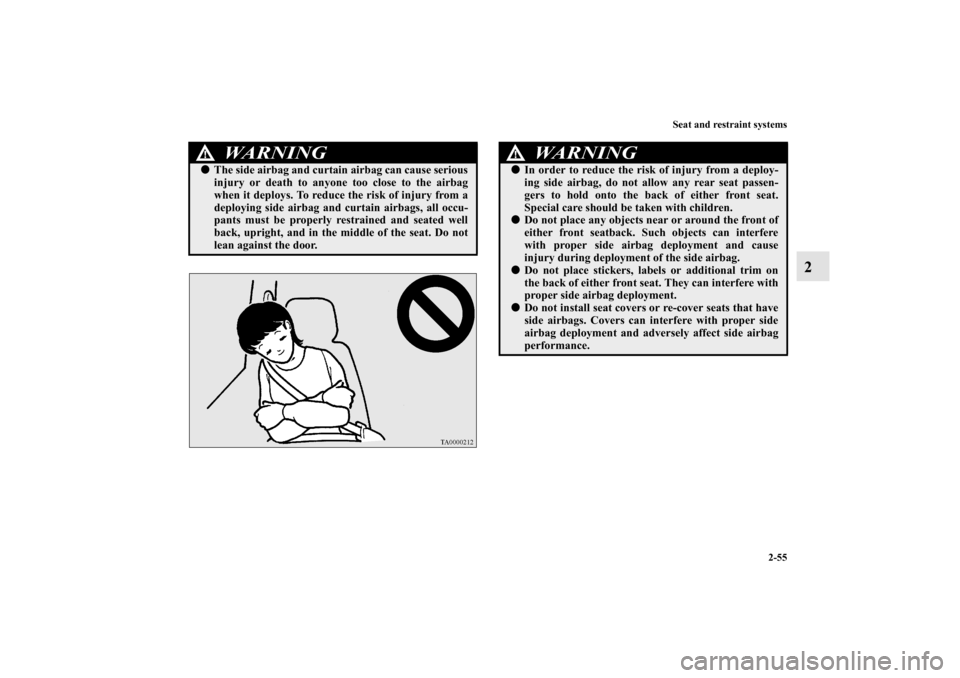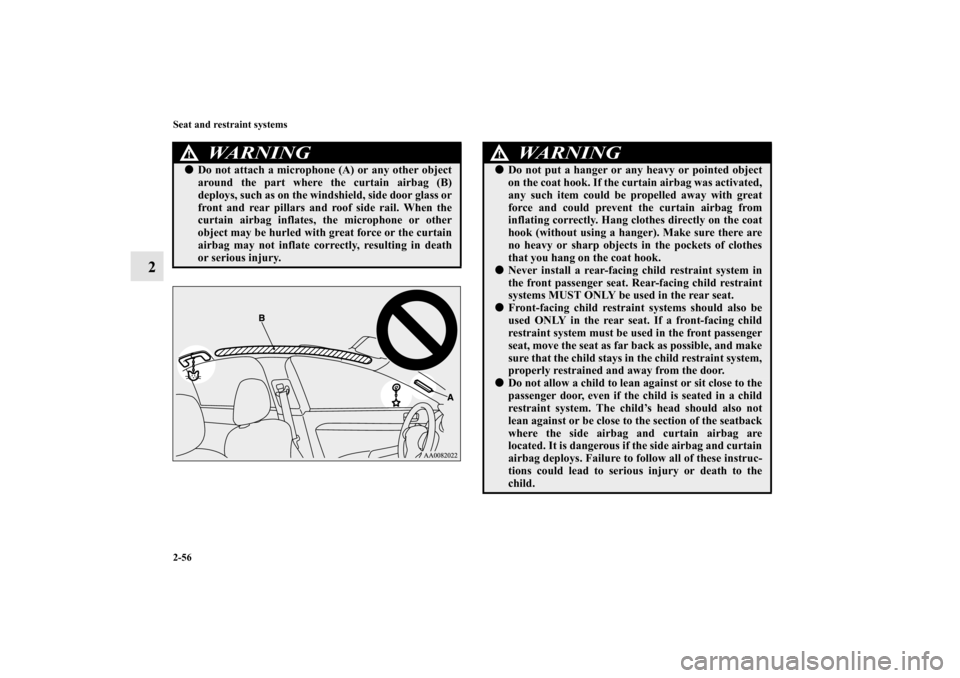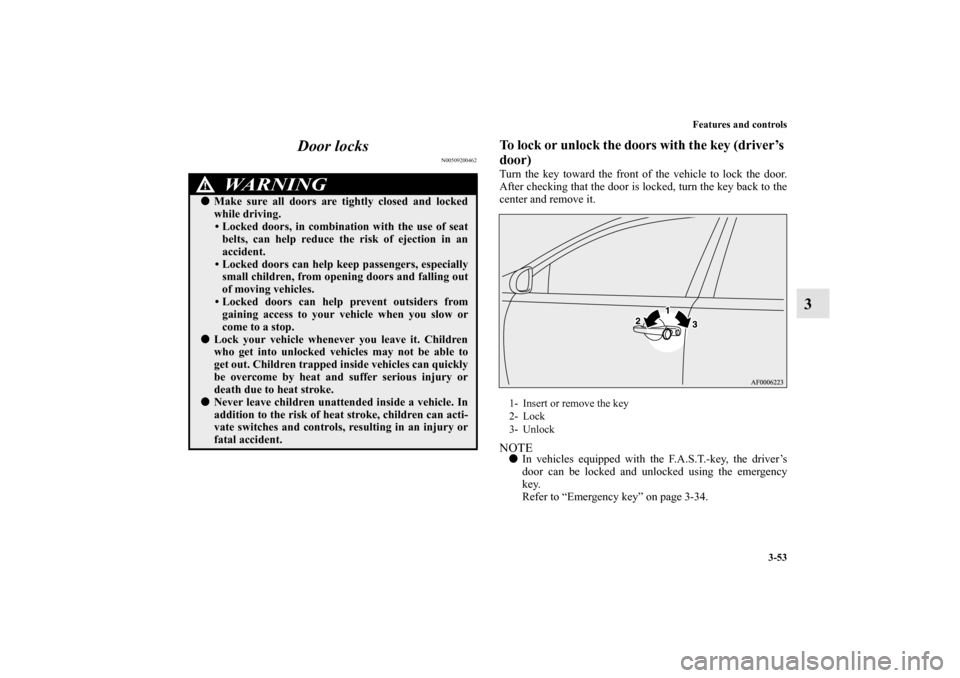Page 72 of 658
Seat and restraint systems
2-39
2
WA R N I N G
!�
NEVER put REAR-FACING CHILD RESTRAINT
SYSTEMS or INFANT RESTRAINT SYSTEMS in
the front passenger seat. This places the infant too
close to the passenger airbag. During deployment of
the airbag, the infant can be seriously injured or
killed.
Rear-facing child restraint systems or infant
restraint systems must only be used in the rear seat.
Airbag
WA R N I N G
!�
FRONT-FACING CHILD RESTRAINT SYS-
TEMS should be used in the rear seat whenever pos-
sible. If they must be used in the front passenger
seat, move the seat to the most rearward position
and make sure the child stays in the child restraint
system, properly restrained. Failure to follow these
instructions could result in serious injury or death to
the child.
BK0103001US.book 39 ページ 2009年8月20日 木曜日 午前10時45分
Page 73 of 658
2-40 Seat and restraint systems
2
How the Supplemental Restraint System works
N00407800421
The SRS includes the following components:
WA R N I N G
!�
Older children should be seated in the rear seat with
their seat belt properly worn, and with an appropri-
ate booster seat (including a booster cushion) if
needed.
Refer to “Children who have outgrown child
restraint systems” on page 2-35.
1- Driver’s airbag
2- SRS warning light
3- Passenger’s airbag off indicator
4- Passenger’s front airbag
5- Front impact sensors
6- Driver’s knee airbag
7- Driver’s seat position sensor
8- Passenger’s seat weight sensors
9- Airbag control unit
BK0103001US.book 40 ページ 2009年8月20日 木曜日 午前10時45分
Page 76 of 658

Seat and restraint systems
2-43
2
Passenger’s seat weight sensors
N00418000292
The passenger’s seat weight sensors are attached to the seat
rails and provide the airbag control unit with information
regarding the weight on the front passenger seat. The airbag
control unit controls deployment of the passenger’s front air-
bag in accordance with the information it receives from this
sensor.
The passenger’s front airbag will not deploy in an impact when
the weight on the seat is sensed to be less than approximately
66 pounds (30 kg). In this case, the passenger’s airbag off indi-
cator will come on.
Refer to “Passenger’s airbag off indicator” on page 2-45.
If there is a problem involving the passenger’s seat weight sen-
sors, the SRS warning in the instrument panel will come on.
Refer to “SRS warning light/display” on page 2-46.
WA R N I N G
!�
If any of the following conditions occur, you should
immediately have your vehicle inspected by an
authorized Mitsubishi Motors dealer as soon as pos-
sible: The SRS warning does not initially come on when
the ignition switch is turned to the “ON” or
“START” position.
The SRS warning does not go out after several sec-
onds.
The SRS warning comes on while you are driving.
WA R N I N G
!�
To ensure that the passenger’s seat weight sensors
can correctly sense the weight being applied to the
seat, observe the following instructions. Failure to
follow these instructions can adversely affect the
performance of the passenger’s airbag system. Adjust the seat to the correct position, and sit well
back against the seatback.
Refer to “Front seats” on page 2-3.
Do not recline the seatback more than necessary.
Never have more than one person (adult or child)
sitting on the seat.
Do not place anything between the seat and the
floor console.
Do not hang anything on the front passenger’s
seatback.
Do not remove the head restraints.
When attaching a child restraint system, secure it
firmly.
Do not place luggage or other objects on the seat.
Do not use a seat cover or a cushion.
Do not modify or replace the seat and seat belt.
Do not place luggage or other objects under the
seat.
Do not place the floor mat on the seat rails.
Do not expose the sensors to liquids or vapors.
Do not subject the sensors to shock.
Do not allow rear-seat occupants to push the front
passenger seat with their feet or force the front
passenger seat upward.
BK0103001US.book 43 ページ 2009年8月20日 木曜日 午前10時45分
Page 77 of 658
2-44 Seat and restraint systems
2
WA R N I N G
! Do not allow rear-seat occupants to grasp the front
passenger’s seatback or put their arms around it.
When attaching a child restraint system in the rear
seat, make sure it does not interfere with the front
seat.
WA R N I N G
!�
If the vehicle is involved in a severe impact, have the
SRS sensors inspected by an authorized Mitsubishi
Motors dealer as soon as possible.
BK0103001US.book 44 ページ 2009年8月20日 木曜日 午前10時45分
Page 88 of 658

Seat and restraint systems
2-55
2
WA R N I N G
!�
The side airbag and curtain airbag can cause serious
injury or death to anyone too close to the airbag
when it deploys. To reduce the risk of injury from a
deploying side airbag and curtain airbags, all occu-
pants must be properly restrained and seated well
back, upright, and in the middle of the seat. Do not
lean against the door.
WA R N I N G
!�
In order to reduce the risk of injury from a deploy-
ing side airbag, do not allow any rear seat passen-
gers to hold onto the back of either front seat.
Special care should be taken with children.
�
Do not place any objects near or around the front of
either front seatback. Such objects can interfere
with proper side airbag deployment and cause
injury during deployment of the side airbag.
�
Do not place stickers, labels or additional trim on
the back of either front seat. They can interfere with
proper side airbag deployment.
�
Do not install seat covers or re-cover seats that have
side airbags. Covers can interfere with proper side
airbag deployment and adversely affect side airbag
performance.
BK0103001US.book 55 ページ 2009年8月20日 木曜日 午前10時45分
Page 89 of 658

2-56 Seat and restraint systems
2
WA R N I N G
!�
Do not attach a microphone (A) or any other object
around the part where the curtain airbag (B)
deploys, such as on the windshield, side door glass or
front and rear pillars and roof side rail. When the
curtain airbag inflates, the microphone or other
object may be hurled with great force or the curtain
airbag may not inflate correctly, resulting in death
or serious injury.
WA R N I N G
!�
Do not put a hanger or any heavy or pointed object
on the coat hook. If the curtain airbag was activated,
any such item could be propelled away with great
force and could prevent the curtain airbag from
inflating correctly. Hang clothes directly on the coat
hook (without using a hanger). Make sure there are
no heavy or sharp objects in the pockets of clothes
that you hang on the coat hook.
�
Never install a rear-facing child restraint system in
the front passenger seat. Rear-facing child restraint
systems MUST ONLY be used in the rear seat.
�
Front-facing child restraint systems should also be
used ONLY in the rear seat. If a front-facing child
restraint system must be used in the front passenger
seat, move the seat as far back as possible, and make
sure that the child stays in the child restraint system,
properly restrained and away from the door.
�
Do not allow a child to lean against or sit close to the
passenger door, even if the child is seated in a child
restraint system. The child’s head should also not
lean against or be close to the section of the seatback
where the side airbag and curtain airbag are
located. It is dangerous if the side airbag and curtain
airbag deploys. Failure to follow all of these instruc-
tions could lead to serious injury or death to the
child.
BK0103001US.book 56 ページ 2009年8月20日 木曜日 午前10時45分
Page 148 of 658

Features and controls
3-53
3 Door locks
N00509200462
To lock or unlock the doors with the key (driver’s
door)Turn the key toward the front of the vehicle to lock the door.
After checking that the door is locked, turn the key back to the
center and remove it.NOTE�
In vehicles equipped with the F.A.S.T.-key, the driver’s
door can be locked and unlocked using the emergency
key.
Refer to “Emergency key” on page 3-34.
WA R N I N G
!�
Make sure all doors are tightly closed and locked
while driving. Locked doors, in combination with the use of seat
belts, can help reduce the risk of ejection in an
accident.
Locked doors can help keep passengers, especially
small children, from opening doors and falling out
of moving vehicles.
Locked doors can help prevent outsiders from
gaining access to your vehicle when you slow or
come to a stop.
�
Lock your vehicle whenever you leave it. Children
who get into unlocked vehicles may not be able to
get out. Children trapped inside vehicles can quickly
be overcome by heat and suffer serious injury or
death due to heat stroke.
�
Never leave children unattended inside a vehicle. In
addition to the risk of heat stroke, children can acti-
vate switches and controls, resulting in an injury or
fatal accident.
1- Insert or remove the key
2- Lock
3- Unlock
BK0103001US.book 53 ページ 2009年8月20日 木曜日 午前10時45分
Page 394 of 658

Driving safety
4-3
4 Vehicle preparation before driving
N00629000542
For a safer and more enjoyable trip, always observe the follow-
ing: Seat belts and seats �
Before starting the vehicle, make certain that you and all
passengers are seated and wearing their seat belts properly
(with children in the rear seat, in appropriate restraints),
and that all the doors and the rear hatch are locked.
�
Move the driver’s seat as far backward as possible, while
still keeping good visibility, and good control of the steer-
ing wheel, brakes, accelerator, and controls. Check the
instrument panel indicators and multi-information display
for any possible problem.
�
Move the front passenger seat as far back as possible.
�
Make sure that infants and small children are properly
restrained in accordance with all laws and regulations.
Floor mats
WA R N I N G
!�
Keep floor mats clear of the pedals by correctly lay-
ing floor mats that are suitable for the vehicle.
To prevent the floor mats from slipping out of posi-
tion, securely retain them using the hook etc.
Placing a floor mat over a pedal or laying one floor
mat on top of another can obstruct pedal operation
and lead to a serious accident.
BK0103001US.book 3 ページ 2009年8月20日 木曜日 午前10時45分